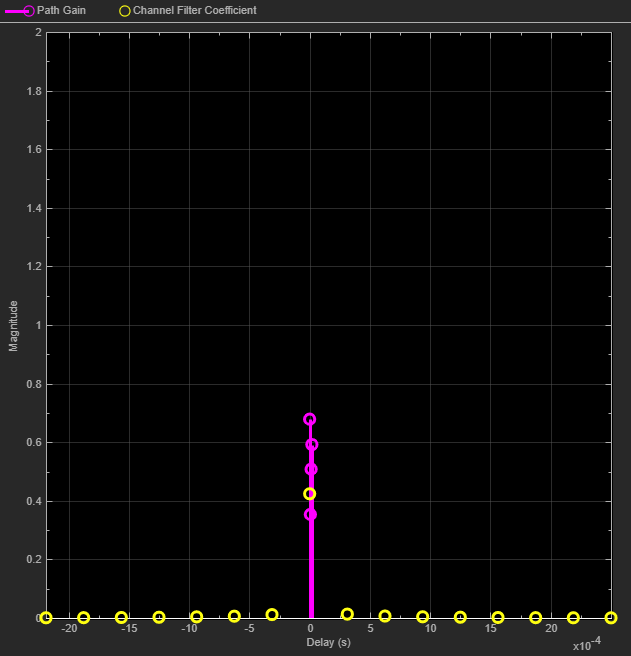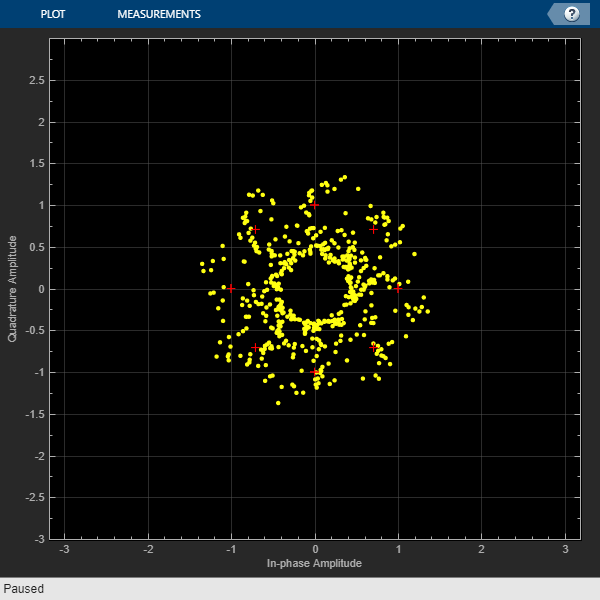stdchan
Construct channel System object from set of standardized channel models
Description
Examples
Set the sample rate and the maximum Doppler shift.
rs = 20e6; fd = 3;
Create a CDMA Typical Urban channel model (TUx) channel object and turn on frequency response visualization.
chan = stdchan('cdmaTUx',rs,fd); chan.Visualization = 'Frequency response';
Generate random data and apply QPSK modulation.
data = randi([0 3],10000,1); txSig = pskmod(data,4,pi/4);
Filter the QPSK signal through the CDMA channel.
y = chan(txSig);

Create a channel model useful for GSM and EDGE simulations. Experiment with low speed and high speed conditions.
Configure Parameters and System Objects
Define variables for the frame configuration.
M = 8; % Modulation order, 8-PSK phaseoffset = 0; % Phase offset for 8-PSK symbols Rbit = 9600; % Input bit rate Rs = Rbit / log2(M); % Symbol rate Nsamples = 5e2; % Number of samples per frame Nframes = 10; % Number of frames
Define the channel configuration for low speed mobile and create a standard channel System object for the equalization test (EQx) with 6 taps profile.
v = 10 * 1e3 / 3600; % Mobile speed (m/s) fc = 1800e6; % Carrier frequency c = physconst('LightSpeed'); % Speed of light in free space fd = v * fc / c; % Maximum Doppler shift of diffuse component channel = stdchan('gsmEQx6',Rs,fd); channel.RandomStream = 'mt19937ar with seed'; % For reproducibility channel.Visualization = 'Impulse and frequency responses'; channel.SamplesToDisplay = '100%';
Create a constellation diagram System object.
refC = pskmod(0:M-1,M,phaseoffset); constDiagram = comm.ConstellationDiagram( ... ReferenceConstellation=refC, ... XLimits=[-3 3], ... YLimits=[-3 3]);
Simulate at Low Speed
for iFrames = 1:Nframes msg = randi([0 M-1],Nsamples,1); modSignal = pskmod(msg,M,phaseoffset); chanOut = channel(modSignal); constDiagram(chanOut); end



Simulate at High Speed
Release and reconfigure the channel and constellation diagram objects.
release(constDiagram); release(channel); v = 120 * 1e3 / 3600; % Mobile speed (m/s) fd = v * fc / c; % Maximum Doppler shift of diffuse component channel.MaximumDopplerShift = fd; % Adjust maximum doppler shift for iFrames = 1:Nframes msg = randi([0 M-1],Nsamples,1); modSignal = pskmod(msg,M,phaseoffset); chanOut = channel(modSignal); constDiagram(chanOut); end



Input Arguments
Channel type, specified as a string or character vector. Valid options are listed in Supported Standards.
Example: stdchan('gsmRAx6c1',rs,fd), configures a
channel model for the GSM typical case for rural area (RAx), 6 taps, case 1,
with a sample rate rs, and maximum Doppler shift
fd
Data Types: char | string
Sample rate in Hertz, specified as a scalar.
Data Types: double
Maximum Doppler shift in Hertz, specified as a scalar.
Data Types: double
Output Arguments
Channel object, returned as a comm.RayleighChannel or comm.RicianChannel
System object.
More About
For GSM, CDMA, and ITU-R HF standards, call stdchan to return a comm.RayleighChannel or comm.RicianChannel
System object modeling one of these profiles.
GSM/EDGE channel models (3GPP TS 45.005 V7.9.0 (2007-2), 3GPP TS 05.05 V8.20.0 (2005-11)):
| Channel model | Profile |
|---|---|
gsmRAx6c1 | Typical case for rural area (RAx), 6 taps, case 1 |
gsmRAx4c2 | Typical case for rural area (RAx), 4 taps, case 2 |
gsmHTx12c1 | Typical case for hilly terrain (HTx), 12 taps, case 1 |
gsmHTx12c2 | Typical case for hilly terrain (HTx), 12 taps, case 2 |
gsmHTx6c1 | Typical case for hilly terrain (HTx), 6 taps, case 1 |
gsmHTx6c2 | Typical case for hilly terrain (HTx), 6 taps, case 2 |
gsmTUx12c1 | Typical case for urban area (TUx), 12 taps, case 1 |
gsmTUx12c1 | Typical case for urban area (TUx), 12 taps, case 2 |
gsmTUx6c1 | Typical case for urban area (TUx), 6 taps, case 1 |
gsmTUx6c2 | Typical case for urban area (TUx), 6 taps, case 2 |
gsmEQx6 | Profile for equalization test (EQx), 6 taps |
gsmTIx2 | Typical case for very small cells (TIx), 2 taps |
CDMA channel models for deployment evaluation (3GPP TR 25.943 V6.0.0 (2004-12)):
| Channel model | Profile |
|---|---|
cdmaTUx | Typical Urban channel model (TUx) |
cdmaRAx | Rural Area channel model (RAx) |
cdmaHTx | Hilly Terrain channel model (HTx) |
ITU-R HF channel models (ITU-R F.1487 (2000)) (FD must be 1 to obtain the correct frequency spreads for these models.):
| Channel model | Profile |
|---|---|
iturHFLQ | Low latitudes, Quiet conditions |
iturHFLM | Low latitudes, Moderate conditions |
iturHFLD | Low latitudes, Disturbed conditions |
iturHFMQ | Medium latitudes, Quiet conditions |
iturHFMM | Medium latitudes, Moderate conditions |
iturHFMD | Medium latitudes, Disturbed conditions |
iturHFMDV | Medium latitudes, Disturbed conditions near vertical incidence |
iturHFHQ | High latitudes, Quiet conditions |
iturHFHM | High latitudes, Moderate conditions |
iturHFHD | High latitudes, Disturbed conditions |
Version History
Introduced in R2007bstdchan(ts,fd,chanType) syntax has been removed.
Compatibility considerations for the
stdchan function includes addition of
a function syntax, removal of a function syntax, and removal of configuration
support for several channel models.
The syntax
chan= stdchan(ts,fd,chantype)stdchanhas removed support for configuration of several channel models by supported standards and associated syntax, compatibility considerations are indicated here:Standard Previous Syntax New Syntax to Return System Object Notes 3GPP, CDMA stdchan(ts,fd,'3gppXXX')stdchan('cdmaXXX',rs,fd)Prefix changed from '
3gpp' to 'cdma'.tsandrsare reciprocal values.GSM stdchan(ts,fd,'gsmXXX')stdchan('gsmXXX',rs,fd)tsandrsare reciprocal values.ITU-R HF stdchan(ts,fd,'iturHFXXX')stdchan('iturHFXXX',rs,fd)tsandrsare reciprocal values.COST207 stdchan(ts,fd,'cost207XXX')N/A In the future
stdchanwill not configure these channels. Usecomm.RayleighChannelorcomm.RicianChannelto configure the channel models for COST207, ITU-R 3G, JTC, HIPERLAN/2, and 802.11a/b/g standards.For guidance mapping parameters, see Rayleigh Channel Compatibility Considerations and Rician Channel Compatibility Considerations.
ITU-R 3G stdchan(ts,fd,'itur3GXXX')N/A JTC stdchan(ts,fd,'jtcXXX')N/A HIPERLAN/2 stdchan(ts,fd,'hiperlan2XXX')N/A 802.11a/b/g stdchan(ts,fd,'802.11X')N/A
Replace instances of rayleighchan with a comm.RayleighChannel
System object. Note the mapping between function parameters and object properties:
| Comparison Between rayleighchan and comm.RayleighChannel | ||||
| rayleighchan | comm.RayleighChannel | Notes | ||
| Properties | Associated functions | Properties | Object functions | |
ChannelType | Indicated by System object name | |||
InputSamplePeriod | SampleRate | Value is reciprocal | ||
DopplerSpectrum | DopplerSpectrum | |||
MaxDopplerShift | MaximumDopplerShift | |||
PathDelays | PathDelays | |||
AvgPathGaindB | AveragePathGains | |||
NormalizePathGains | NormalizePathGains | |||
StoreHistory | Adjacent with the plot function of
rayleighchan | |||
PathGains | object call (step) | Second output returned by a call of the object
(step) | ||
ChannelFilterDelay | info | Returned by a call to info | ||
ResetBeforeFiltering | reset | Call reset before each object
function call (step) | ||
NumSamplesProcessed | info | Returned by a call to info | ||
filter | object call (step) | First output returned by a call of the object
(step) | ||
reset | reset | |||
plot |
| object call (step) | The | |
StorePathGains | PathGainsOutputPort | |||
Replace instances of ricianchan with a comm.RicianChannel
System object. Note the mapping between function parameters and object properties:
| Comparison Between ricianchan and comm.RicianChannel | ||||
| ricianchan | comm.RicianChannel | Notes | ||
| Properties | Associated functions | Properties | Object functions | |
ChannelType | Indicated by System object name | |||
InputSamplePeriod | SampleRate | Value is reciprocal | ||
DopplerSpectrum | DopplerSpectrum | |||
MaxDopplerShift | MaximumDopplerShift | |||
PathDelays | PathDelays | |||
KFactor | KFactor | |||
DirectPathDopplerShift | DirectPathDopplerShift | |||
DirectPathInitPhase | DirectPathInitialPhase | |||
AvgPathGaindB | AveragePathGains | |||
NormalizePathGains | NormalizePathGains | |||
StoreHistory | Adjacent with the plot function of
ricianchan | |||
StorePathGains | PathGainsOutputPort | |||
PathGains | object call (step) | Second output returned by a call of the object
(step) | ||
ChannelFilterDelay | info | Returned by a call to info | ||
ResetBeforeFiltering | reset | Call reset before each object
function call (step) | ||
NumSamplesProcessed | info | Returned by a call to info | ||
filter | object call (step) | First output returned by a call of the object
(step) | ||
reset | reset | |||
plot |
| object call (step) | The | |
MATLAB Command
You clicked a link that corresponds to this MATLAB command:
Run the command by entering it in the MATLAB Command Window. Web browsers do not support MATLAB commands.
选择网站
选择网站以获取翻译的可用内容,以及查看当地活动和优惠。根据您的位置,我们建议您选择:。
您也可以从以下列表中选择网站:
如何获得最佳网站性能
选择中国网站(中文或英文)以获得最佳网站性能。其他 MathWorks 国家/地区网站并未针对您所在位置的访问进行优化。
美洲
- América Latina (Español)
- Canada (English)
- United States (English)
欧洲
- Belgium (English)
- Denmark (English)
- Deutschland (Deutsch)
- España (Español)
- Finland (English)
- France (Français)
- Ireland (English)
- Italia (Italiano)
- Luxembourg (English)
- Netherlands (English)
- Norway (English)
- Österreich (Deutsch)
- Portugal (English)
- Sweden (English)
- Switzerland
- United Kingdom (English)